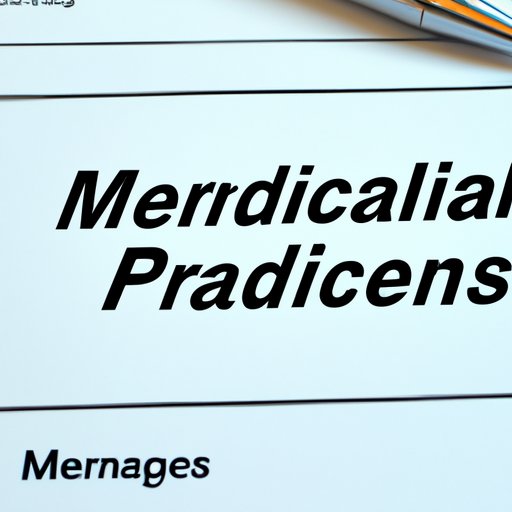Introduction
Medicare is a federal health insurance program that covers millions of Americans over the age of 65. While Medicare enrollment may seem overwhelming, understanding when to sign up for Medicare and the different parts of Medicare is crucial to avoiding late enrollment penalties and receiving the healthcare coverage you need. In this article, we’ll discuss the basics of Medicare enrollment and provide tips for making the process easy and stress-free.
Understanding When You Need to Sign Up for Medicare: A Quick Guide
Medicare is divided into four parts: Part A, Part B, Part C, and Part D. Part A and Part B are considered Original Medicare. Part A generally covers hospital stays, skilled nursing facilities, hospice care, home health care, and other medically necessary services. Part B covers doctor visits, preventive care, and medically necessary services. Parts C and D are considered Medicare Advantage and prescription drug coverage, respectively.
Eligibility for Medicare is generally based on age or disability. Those aged 65 or older, those under 65 with certain disabilities, and those with End-Stage Renal Disease (ESRD) qualify for Medicare.
There are different scenarios that require you to sign up for Medicare. If you’re turning 65 and are not already receiving Social Security or Railroad Retirement Board benefits, you will need to sign up for Medicare during the Initial Enrollment Period (IEP). If you’re under 65 with certain disabilities, you may qualify for Medicare part A and B after being eligible for Social Security Disability Insurance (SSDI) for 24 months.
To determine when you need to sign up for Medicare, consider your specific circumstances. Ask yourself if you’re currently receiving Social Security benefits or Railroad Retirement Board benefits and if you have any other health insurance coverage through an employer or union.
Avoiding Penalties: A Complete List of Medicare Enrollment Deadlines
Failure to enroll in Medicare during the correct enrollment period can result in late enrollment penalties. The penalties are a percentage of the premium for each year you were eligible for Medicare but not enrolled. These penalties can be significant and last as long as you have Medicare.
There are several enrollment periods to keep track of. The IEP is a seven-month window that starts three months before the month you turn 65 and ends three months after the end of that month. The General Enrollment Period (GEP) is January 1 to March 31 each year, and you can sign up for Medicare Part A and/or B during this time. However, if you didn’t enroll during your IEP and don’t have creditable health coverage, you may face a late enrollment penalty. The Special Enrollment Period (SEP) is available for those who have employer coverage, retiree coverage, or COBRA coverage. The Open Enrollment Period is October 15 to December 7 each year for Medicare Advantage and Medicare prescription drug coverage.
To avoid late enrollment penalties, it’s important to understand each enrollment period, eligibility requirements, and sign up for Medicare during the correct period.
Turning 65 Soon? Here’s What You Need to Know About Medicare Enrollment
Turning 65 is a significant milestone for Medicare enrollment. If you’re already receiving Social Security or Railroad Retirement Board benefits, you will be automatically enrolled in Medicare. If you’re not receiving these benefits, you will need to enroll during your IEP.
When turning 65, you have several options for Medicare coverage. You can enroll in Original Medicare (Part A and B), enroll in a Medicare Advantage plan (Part C), or enroll in a standalone prescription drug plan (Part D). It’s important to evaluate which option works best for you, based on your personal health needs and budget.
Navigating Medicare enrollment for those turning 65 can be confusing, but with the right information and resources, it can be a smooth process.
Breaking Down Medicare’s Enrollment Periods and Eligibility Requirements
Medicare enrollment periods vary based on eligibility requirements for each part of Medicare. For example, the IEP is for those turning 65 or newly eligible for Medicare due to a disability. However, the SEP is only available for those with employer coverage, retiree coverage, or COBRA coverage.
To determine which Medicare plan is right for you, consider your healthcare needs, budget, and eligibility requirements. If you’re new to Medicare, you may want to consider Original Medicare as a starting point, then evaluate if a Medicare Advantage plan or prescription drug plan is necessary.
The Importance of Timely Enrollment in Medicare: Tips and Tricks for Every Age
Timely Medicare enrollment is crucial to avoid late enrollment penalties and ensure you have the healthcare coverage you need. No matter your age, it’s important to stay informed about Medicare enrollment and eligibility requirements.
Some tips for navigating Medicare enrollment include reviewing all available resources, asking questions and seeking guidance when needed, and considering all Medicare options before enrolling.
Conclusion
Enrolling in Medicare may seem overwhelming, but it doesn’t have to be. Understanding when to sign up for Medicare, the different parts of Medicare, and the enrollment periods and eligibility requirements can make the process much easier. Remember to consider your personal healthcare needs and budget when determining which Medicare plan is right for you. Don’t forget that timely enrollment is crucial to avoiding late enrollment penalties.
Take charge of your healthcare coverage today and take advantage of all that Medicare has to offer.
(Note: Is this article not meeting your expectations? Do you have knowledge or insights to share? Unlock new opportunities and expand your reach by joining our authors team. Click Registration to join us and share your expertise with our readers.)
